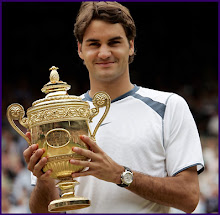WELCOME
Also dont forget to visit my new website WWW.BHARATVERMA.IN
Support Us
Saturday, December 01, 2007
Thursday, October 25, 2007
Monday, October 15, 2007
Tuesday, October 02, 2007
Saturday, September 29, 2007
Saturday, September 15, 2007
Tuesday, September 11, 2007
Thursday, August 30, 2007
Saturday, August 25, 2007
Tuesday, August 14, 2007
Tuesday, August 07, 2007
Sunday, August 05, 2007
Friday, August 03, 2007
Work on your foot speed
Here are some numbers for you:
• Average seconds per point:
Clay – 10
Hard – 5
Grass – 2.8
• A player averages 4.2 directional changes per point.
• Average distance covered per stroke is 4 meters.
• The ratio of time playing tennis and time walking around the court is 35:65.
By looking at this data, it’s easy to see that tennis is fast game full of explosive movements. You should train your body accordingly. Jogging will give you endurance, which is good for long matches, but when do you ever jog to a ball to hit a shot? You need speed. Practice sprinting short distances in all different directions (just like you would on a tennis court) and then rest. Do a series of sprints where you run for 15 seconds, then rest for 45 more. Simulate the action of a real point. Try to incorporate sets of hops or jumps, or any movement that will increase your quickness and explosion. You want to train your body to be able to run hundreds of short races – not one long one.
Saturday, July 28, 2007
Thursday, July 26, 2007
Sunday, July 22, 2007
Friday, July 20, 2007
Sunday, July 15, 2007
Thursday, July 12, 2007
Monday, July 09, 2007
Saturday, June 30, 2007
Wednesday, June 27, 2007
Tuesday, June 19, 2007
Thursday, June 14, 2007
Saturday, June 09, 2007
Saturday, June 02, 2007
Five Things to Learn from Roger Federer
 Federer Moving ForwardFive things you can learn from Roger Federer’s victory in the 2004 U.S. Open men’s final.
Federer Moving ForwardFive things you can learn from Roger Federer’s victory in the 2004 U.S. Open men’s final.1. KICK IT OLD SCHOOL
I like to say that Roger Federer has brought the old-school game of tennis to the modern world. He plays with tremendous variety of shot and strategy, and it was all on display in his 6-0, 7-6 (3), 6-0 rout of Lleyton Hewitt, a player whose tenacity usually gives his opponents fits. What Federer shows is that there is no substitute for being a well-rounded player and having options when you step on the court.
2. BE PATIENT
Because Hewitt plays a conservative, defensive style, it was up to Federer to decide when to go on the offensive. Hewitt couldn’t hurt him from the baseline, so Federer waited for a ball that would allow him to take control of the point. When you face a determined counterpuncher, try not to get overeager. The surest way to defeat such an opponent is to be patient and work each point until you have a clear opening.
3. HANG TOUGH
Even though Hewitt lost the first eight games, he still fought hard. If he had gotten a few lucky breaks he would have been back in the match. When you’re playing an opponent who is on fire, keep making him hit shots. If he continues to hit winners, then he’s too good that day. But many times you’ll weather the storm. Federer cooled off considerably in the second set, and Hewitt kept plugging away and nearly stole it.
4. PLAY BIG IN THE BREAKER
Federer realized the importance of the secondset tiebreaker. Winning it would give him a two-set lead and destroy the momentum Hewitt had gained by clawing his way back into the match. Federer elevated his game and reeled off the first four points of the breaker. Instead of trying to take the initiative, Hewitt played the points hoping Federer would make errors. You have to put a premium on every point in a tiebreaker. Play each one as if it’s a break point.
5. TAKE THE BALL EARLY
Federer’s ability to move from well behind the baseline to the middle of the court, from defense to offense, is unbelievable. Once he recognizes that a ball is going to be short, he moves up to take it early. That’s how he hit most of his winners against Hewitt. If you take the ball even a half-second earlier, that’s better than adding 10 m.p.h. to your shot because you’re being aggressive while still playing within your comfort zone.
Tuesday, May 29, 2007
Friday, May 25, 2007
Shoes for different court types.
Clay courts with slide
The new breed in clay / sliding court shoes are sharp edged herring bone that cover the entire sole and even roll up on the side of the shoe to give maximum grip and an "even or measurable" slide characteristic. The idea being that the clay will fall out after each step in order to allow maximum grip on each consecutive step. Sharp Herring bone bite better, but wear out faster. A softer material is used for maximizing drag.
Hard court
Due to the stop/start nature of hard court tennis, it is very important to get a quality shoe. Think of your future! Durability, shock absorption coupled with good ankle support and overall comfort. Most profiles will work quite well but most won't last too long. Notice the turning circle on the shoe above. This puts the most amount of rubber where you need it with the freedom to move it. The brands that offer a guarantee on the sole are normally very good. Addidas Torsion is a great buy with its six-month guarantee. Kswiss shoes are very good though a little heavy however what you gain in quality far outweighs the weight issue.

